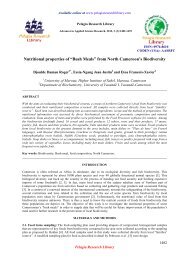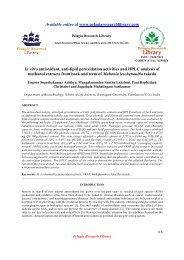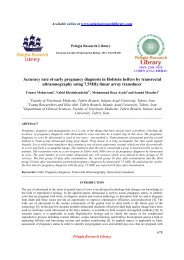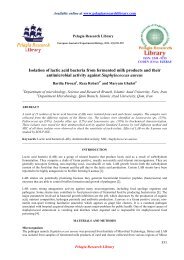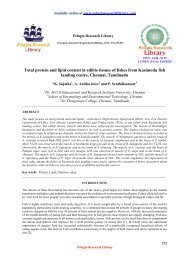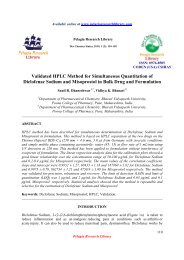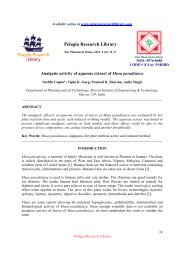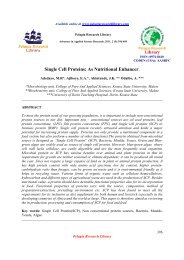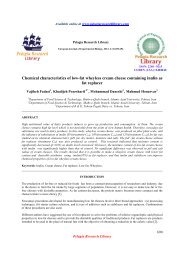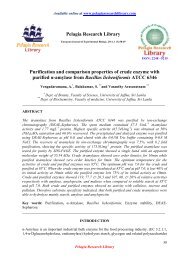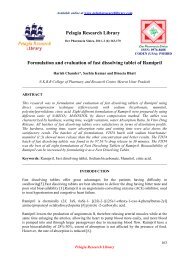clove - Pelagia Research Library
clove - Pelagia Research Library
clove - Pelagia Research Library
You also want an ePaper? Increase the reach of your titles
YUMPU automatically turns print PDFs into web optimized ePapers that Google loves.
Available online at www.pelagiaresearchlibrary.com<br />
<strong>Pelagia</strong> <strong>Research</strong> <strong>Library</strong><br />
Der Chemica Sinica, 2013, 4(3):120-125<br />
ISSN: 0976-8505<br />
CODEN (USA) CSHIA5<br />
Estimation of antioxidant activities of fixed and volatile oils extracted from<br />
Syzygium aromaticum (<strong>clove</strong>)<br />
Fatma A. Elslimani, Maraia F. Elmhdwi, Fakhri Elabbar and Otman O. Dakhil<br />
Department of Chemistry, Faculty of Science, Benghazi University, Libya<br />
_____________________________________________________________________________________________<br />
ABSTRACT<br />
The antioxidant activity of fixed and volatile oils were extracted from the dry buds of Syzygium aromaticum (<strong>clove</strong>)<br />
are evaluated by the scavenging activity on 1,1-diphenyl-2-picrylhydrazyl (DPPH) and the reducing power assay,<br />
total phenolic and flavonoids are also detected. The result showed that the fixed oil had highest TPC and TFC than<br />
the volatile oil in comparison with the standard (pyrogallol, quercetin). Also based on the DPPH radical scavenging<br />
activity and reducing power assay the fixed oil is rather strong than the volatile oil, the result compared to standard<br />
antioxidant L-ascorbic acid and it is found increase with increase in concentration. Finally, the present study<br />
suggests that both fixed and volatile extracted from S.aromaticum have potential activity as source of natural<br />
antioxidant.<br />
Keywords; syzybium aromaticum (<strong>clove</strong>), 1,1-diphenyl-2-picrylhdrazyl (DPPH)<br />
_____________________________________________________________________________________________<br />
INTRODUCTION<br />
Syzygium aromaticum (L.) commonly called <strong>clove</strong>, which belongs to the family Myrtaceae, is an important aromatic<br />
spice. Clove is commercially cultivated in India, Madagascar, Sri Lanka, Indonesia and the south of China. Now-adays<br />
it also cultivated in Bangladesh in a small scale. The <strong>clove</strong> oil especially has been used by traditional folk<br />
healers as well as by modern pharmacists and dentists in alleviating the symptoms associated with toothache and<br />
dental decay. Also in the treatment of skin ulcers [1].<br />
The <strong>clove</strong> herbal tea is prepared by boiling and steeping the dried <strong>clove</strong> buds in water. This tea is seen as a cure for<br />
problems such as nausea and as an aid to eliminating excess gas in the stomach and the intestines. Clove bud oil has<br />
biological activities, such as antibacterial, antifungal, and antioxidant properties, and are used traditionally as<br />
flavoring agent and antimicrobial material in food, It is clear that common spices S. aromaticum has broad spectrum<br />
pharmacological effects against various microorganism as well as in treatment of different health problems in human<br />
beings. Chemicals present in S. aromaticum have significant effect against cancer, cardiovascular rich factors, and as<br />
antidibetic/antioxidant, [2]. And also shows antibacterial properties against food borne pathogens (S. aureus, P.<br />
aeruginosa, E. coli) [3]. Oil of Clove showed maximum antifungal activity against Aspergillus flavus, A. niger, A.<br />
terreus, A. oryzae, A. fumigatus, Fusarium moniliforme, F. solani and Penicillium fungal species [4]. With other 16<br />
medicinal plants, <strong>clove</strong> used in the treatment of Jaundice in the Satra culture people that related to their livelihood<br />
as well as socio-economic and spiritual aspect [5].<br />
Ample experimental and epidemiological studies support the involvement of oxidative stress in pathogenesis and<br />
progression of many diseases. It is quite known that oxygen, indispensable for maintaining life, sometimes becomes<br />
toxic and results in the generation of most aggressive agents such as reactive oxygen species (ROS). The high<br />
reactivity of ROS can trigger a host of disorders in biological systems. Endogenous antioxidant enzymes are<br />
responsible for preventing and neutralizing the free radical induced damages of tissues. Oxidative stress is an<br />
<strong>Pelagia</strong> <strong>Research</strong> <strong>Library</strong><br />
120
Fatma A. Elslimani et al Der Chemica Sinica, 2013, 4(3):120-125<br />
_____________________________________________________________________________<br />
outcome of imbalance between ROS production and antioxidant defences, which in turn evokes a series of events<br />
deregulating the cellular functions [6]. Antioxidant is a substance that has the ability to delay the oxidation of a<br />
substrate by inhibiting the initiation or propagation of oxidizing chain reactions caused by free radicals. It plays<br />
important roles to prevent fats and oils from becoming rancid and protects human body from detrimental effects of<br />
free radicals. Synthetic antioxidants such as butylated hydroxytoluene (BHT), butylated hydroxyanisole (BHA), tertbutylhydroquinone<br />
(TBHQ) and propyl gallate (PG) have been widely used around the world for decades. However,<br />
they are being scrutinized for possible toxic and carcinogenic effects. As a result, an intense new area of research<br />
has been developed concerning the search for identification and characterization of naturally occurring antioxidants.<br />
Natural antioxidants are more ideal as food additives, not only for their free radical scavenging properties, but also<br />
on the belief that natural products are healthier and safer than synthetic ones; thus they are more readily acceptable<br />
to the modern consumers [7].<br />
Numerous aromatic, spicy and medicinal plants have been examined for their antioxidative potential [8]. Herbs and<br />
spices that are usually used to flavour dishes are among the tremendous sources of phenolic compounds, which have<br />
been reported to show good antioxidant activity, Chemical constituents with antioxidant activity found in high<br />
concentrations in plants determine their considerable role in the prevention of various degenerative diseases [9]. The<br />
purpose of this study is to evaluate the antioxidant properties of the fixed and volatile oils extracted from the buds of<br />
Syzygium aromaticum (<strong>clove</strong>). A recent study presented the sources, types, mechanism of action and damaged<br />
caused by free radicals [10].<br />
MATERIALS AND METHODS<br />
Plant material: The buds of S. aromaticum of good quality were obtained from a local market, Benghazi, Libya,<br />
2012.<br />
Chemicals: 1,1-Diphenylpicrylhydrazyl (DPPH) was obtained from Sigma Chemicals, ascorbic acid, Folin-<br />
Ciocalteu reagent, ferric chloride, potassium ferricyanide, monobasic dihydrogen phosphate, dibasic monohydrogen<br />
phosphate, trichloro acetic acid ,sodium carbonate, petroleum ether, anhydrous sodium sulfate and pyrogallol<br />
obtained from biochemistry laboratory of chemistry department.<br />
Sample preparation:<br />
Extraction of fixed oil: The fixed oil from the powdered buds of S. aromaticum ( 100g) was extracted with light<br />
petroleum ether (40-60 C°) in a soxhlet apparatus for about 4h and the solvent was removed by rotary vacuum<br />
evaporator.<br />
Extraction of volatile oil: The dry powdered buds of S. aromaticum (200 g) were subjected to hydrodistillation<br />
using Clevenger apparatus for 6h for isolation of volatile oils separately (Clevenger, 1928). The oil samples were<br />
stored at 7°C in air-tight containers after drying them over anhydrous sodium sulfate and filtered before analysis.<br />
Antioxidant activities assays and quantitative analysis:<br />
Total phenolic content (TPC): Phenolic compound concentration in the fixed and volatile oils extracted from<br />
S.aromaticum (<strong>clove</strong>) was estimated using the colorimetric method based on Folin-Ciocalteu reagent [11]. 0.05 ml<br />
of the oils at different concentration "100,200,300,400,500 µg/ml" was mixed 0.05 ml of Folin-Ciocalteu reagent.<br />
Then 0.5 ml of 15% sodium carbonate solution was added to the mixture and then the adjusted to 1 ml with 0.4 ml<br />
of distilled water. The reaction was allowed to stand for 10 min, after which the absorbance was read at 725 nm by<br />
UV-visible spectrophotometer. Quantification was done with respect to stander calibration curve of Pyrogallol the<br />
results were expressed as pyrogallol "µg/ml". Estimation of the phenolic compounds was carried out in triplicate.<br />
The results were mean values ± standard deviations.<br />
Total flavonoids content: Aluminum chloride colorimetric method was used for determination [12]. 2 ml of<br />
Different concentration "100, 200, 300, 400, 500 µg/ml "of oils mixed with 0.1ml of 10% aluminum chloride, 0.1 ml<br />
of 1 M potassium acetate and 2.8 ml of distilled water. It remained at room temperature for 30 min; the absorbance<br />
of the reaction mixture was measured at 415 nm with a UV-visible spectrophotometer. The calibration curve was<br />
prepared by preparing quercetin solution in methanol at concentrations "100 to 500 µg/ml".<br />
Reducing power assay (RPA): The reducing power was determined according to the [13]. 2ml of the oils with<br />
different concentration "100,200,300,400,500µg/ml" was mixed with 2.5 ml phosphate buffer (0.2 M, pH 6.6) and<br />
2.5 ml potassium ferricyanide then mixture was incubated in water bath at 50 C 0 for 20 minutes and 2.5 ml of<br />
trichloroacetic acid was added to the mixture which was then centrifuged at 3000 rpm for 10 minutes. Finally 2.5 ml<br />
of the supernatant was mixed with 2.5 ml of distilled water and 1 ml Fecl3, substances, which have reduction<br />
<strong>Pelagia</strong> <strong>Research</strong> <strong>Library</strong><br />
121
Fatma A. Elslimani et al Der Chemica Sinica, 2013, 4(3):120-125<br />
_____________________________________________________________________________<br />
potential react with potassium ferricyanide (Fe 3+ ) to form potassium ferricyanide (Fe 2+ ), which then reacts with<br />
ferric chloride to form ferric ferrous complex that has an absorption maximum at 700nm by UV-Visible<br />
spectrophotometer. Quantification was done with respect to stander calibration curve of ascorbic acid the results<br />
were expressed as ascorbic acid "µg/ml".<br />
Potassium ferricyanide + ferric chloride antioxidant potassium ferricyanide + ferrous chloride<br />
DPPH free Radical Scavenging activity (RSA): The antioxidant activity of the fixed and volatile oils was<br />
measured in terms of hydrogen donating or radical-scavenging ability using the stable DPPH method as modified by<br />
[14]. The reaction mixture containing 2 ml of the oil at different concentration"100,200,300,400,500µg/ml" and 2ml<br />
of DPPH (0.2mM) was vigorously shaken and incubated in darkness at room temperature for 30 minutes. When the<br />
DPPH reacted with an antioxidant compound in an oil that can donate hydrogen, it was reduced and resulting<br />
decrease in absorbance at 517nm using UV-visible spectrophotometer, and the mean values were obtained from<br />
triplicate experiments. The percentage of the remaining DPPH was plotted against the sample concentration. A<br />
lower value indicates greater antioxidant activity. Radical scavenging activity was expressed as percent of inhibition<br />
and was calculated using the following formula:-<br />
%DPPH " RSA" = [ Abs. of Control – Abs. of Sample / Abs. of Control ] x 100<br />
RESULTS AND DISCUSSION<br />
A similar strategy was used recently to study the Antioxidant activity and to estimate the total phenolic and<br />
flavonoid contents of the root extract of Amaranthus spinosus [15].<br />
Total phenolic content: Folin-Ciocalteu reagent, a mixture of phosphotungstic (H3PW12O40) and phosphomolybdic<br />
(H3PMo12O40) acids, is reduced to blue oxides of tungstene (W8O23) and molybdene (Mo8O23) during phenol<br />
oxidation. This reaction occurs under alkaline condition provided by sodium carbonate. The intensity of blue colour<br />
reflects the quantity of phenolic compounds, which can be measured using spectrophotometer [7]. Figure (2) shows<br />
the total phenolic compound founds in fixed and volatile oil where the fixed oil contains high TPC, the results<br />
suggest that the TPC varied significantly between fixed and volatile oil may due to in the difference in the extraction<br />
process. The colour measurement which was non-specific on phenol and perhaps there were other component that<br />
can react with folin-Ciocalteu reagent such as saponin. The results expressed according to Pyrogallol as a phenolic<br />
compound in figure (1).<br />
Abs. at 765 nm<br />
2.5<br />
2<br />
1.5<br />
1<br />
0.5<br />
0<br />
0.030x<br />
- 0.004y<br />
=<br />
0.990=<br />
² R<br />
0 200 400 600<br />
Figure ( 1 )<br />
CONC. of ( µg/ml)…<br />
Total flavonoids content: Due to their low redox potentials flavonoids are thermodynamically able to reduce most<br />
oxidizing free radicals relevant to biological systems such as superoxide, peroxyl, alkoxyl, and hydroxyl radicals<br />
[16]. The principle of aluminum chloride colorimetric method is that aluminum chloride forms acid stable<br />
complexes with the C-4 keto group and either the C-3 or C-5 hydroxyl group of flavones and flavonols. In addition,<br />
aluminum chloride forms acid labile complexes with the ortho-dihydroxyl groups in the A- or B-ring of flavonoids<br />
[12]. The results obtained in this study in the figure (4) indicate that the fixed and volatile oils contain slightly<br />
amount of flavonoids compounds as compared with the quercetin in figure(3) which used as standard.<br />
Abs. at 765nm<br />
2.5<br />
0.5<br />
<strong>Pelagia</strong> <strong>Research</strong> <strong>Library</strong><br />
2<br />
1.5<br />
1<br />
0<br />
0 200 400 600<br />
Figure ( 2 )<br />
CONC. ( µg/ml )…<br />
fixed oil<br />
volatile oil<br />
122
Abs. at 415 nm<br />
Fatma A. Elslimani et al Der Chemica Sinica, 2013, 4(3):120-125<br />
_____________________________________________________________________________<br />
1.4<br />
1.2<br />
1<br />
0.8<br />
0.6<br />
0.4<br />
0.2<br />
0<br />
Abs. at 415 nm<br />
Reducing power assay: The reducing power assay is associated with antioxidant activity and may serve as a<br />
significant reflection of the antioxidant activity. Compounds with reducing power indicate that they are electron<br />
donors and can reduce the oxidized intermediates. In this assay the yellow colour of the test solution change to<br />
various shades of green and blue depending on the reducing power of each compound. Presence of the reducers<br />
causes the conversion of the ferricyanide to the ferrous form [17].<br />
Standard curve of ascorbic acid is shown in figure (5).and the figure (6) shows the reducing power assay of fixed<br />
and volatile oils of S.aromaticum. The reducing power assay increase with increase in concentration and the fixed<br />
oil exhibit higher reducing activity than the volatile oil.<br />
Abs. at 700 nm<br />
1.4<br />
1.2<br />
1<br />
0.8<br />
0.6<br />
0.4<br />
0.2<br />
0<br />
0.043x<br />
+ 0.002y<br />
=<br />
0.997=<br />
² R<br />
0 200 400 600<br />
CONC. ( µg/ml )<br />
Figure ( 3 )<br />
Total flavonoids content of qurecetin<br />
0.031x<br />
- 0.002y<br />
=<br />
0.996=<br />
² R<br />
0 200 400 600<br />
CONC. (µg/ml)<br />
Figure ( 5 )<br />
Reducing power assay of Vit.C<br />
DPPH free radical scavenging activity (RSA): DPPH radical scavenging activity assay assessed the ability of the<br />
extract to donate hydrogen or to scavenge free radicals. DPPH radical is a stable free radical and when it reacts with<br />
an antioxidant compound which can donate hydrogen, it is reduced to diphenylpicrylhydrazine. The changes in<br />
colour (i.e. from deep-violet to light-yellow) can be measured spectrophotometrically [7].<br />
The <strong>clove</strong> oil buds when mixed with the DPPH decolorized it due to hydrogen donating ability, it was observed that<br />
the scavenging activity of fixed oil of <strong>clove</strong> buds at all concentrations from 100 to 500 µg/ml is rather strong than<br />
the volatile oil. Figure (7) show the radical scavenging activity of fixed and volatile oil and the ascorbic acid which<br />
used as standard antioxidant.<br />
Abs. at 700 nm<br />
1<br />
0.9<br />
0.8<br />
0.7<br />
0.6<br />
0.5<br />
0.4<br />
0.3<br />
0.2<br />
0.1<br />
0<br />
<strong>Pelagia</strong> <strong>Research</strong> <strong>Library</strong><br />
fixed oil<br />
volatile oil<br />
0 200 400 600<br />
CONC. ( µg/ml)<br />
Figure ( 4 )<br />
Total flavonoids content of fixed and volatile oils<br />
3.5<br />
3<br />
2.5<br />
2<br />
1.5<br />
1<br />
0.5<br />
0<br />
fixed oil<br />
volatile oil<br />
0 200 400 600<br />
CONC. ( µg/ml )<br />
Figure ( 6 )<br />
Reducing power assay of fixed and volatile oils<br />
123
Fatma A. Elslimani et al Der Chemica Sinica, 2013, 4(3):120-125<br />
_____________________________________________________________________________<br />
scavenging activity (%)<br />
% 120<br />
% 100<br />
% 80<br />
% 60<br />
% 40<br />
% 20<br />
% 0<br />
Concentration of<br />
Pyrogallol<br />
" µg/ml "<br />
Mean ± Standard<br />
Deviation<br />
1. Total phenolic content:<br />
concentration<br />
of fixed oil<br />
" µg/ml "<br />
Mean ± Standard<br />
Deviation<br />
<strong>Pelagia</strong> <strong>Research</strong> <strong>Library</strong><br />
concentration of<br />
volatile oil<br />
" µg/ml "<br />
Mean ± Standard<br />
Deviation<br />
100 0.410 ± 0.0320 100 0.356 ± 0.0322 100 0.287 ± 0.00342<br />
200 0.799 ± 0.0220 200 0.795 ± 0.0220 200 0.483 ± 0.0087<br />
300 1.333 ± 0.0045 300 1.120 ± 0.0120 300 0.987 ± 0.0253<br />
400 1.828 ± 0.0117 400 1.525 ± 0.0056 400 1.380 ± 0.0236<br />
500 2.105 ± 0.0225 500 1.980 ± 0.0048 500 1.789 ± 0.0338<br />
Concentration of<br />
qurecetin<br />
" µg/ml "<br />
Mean ± Standard<br />
Deviation<br />
2. Total flavonoids content:<br />
concentration<br />
of fixed oil<br />
" µg/ml "<br />
Mean ± Standard<br />
Deviation<br />
concentration of<br />
volatile oil<br />
" µg/ml "<br />
Mean ± Standard<br />
Deviation<br />
100 0.279 ± 0.0920 100 0.194 ± 0.0022 100 0.173 ± 0.0033<br />
200 0.560 ± 0.0350 200 0.412 ± 0.0020 200 0.328 ± 0.0020<br />
300 0.834 ± 0.0034 300 0.587 ± 0.0450 300 0.510 ± 0.0220<br />
400 1.066 ± 0.0098 400 0.750 ± 0.0336 400 0.675 ± 0.0276<br />
500 1.300 ± 0.0065 500 0.860 ± 0.0348 500 0.842± 0.0355<br />
Concentration of<br />
vitamin C<br />
" µg/ml "<br />
A. According to absorbance:<br />
Mean ± Standard<br />
Deviation<br />
3. Reducing power assay:<br />
concentration<br />
of fixed oil<br />
" µg/ml "<br />
Mean ± Standard<br />
Deviation<br />
concentration of<br />
volatile oil<br />
" µg/ml "<br />
Mean ± Standard<br />
Deviation<br />
100 0.201 ± 0.0280 100 0.895 ± 0.0122 100 0.791 ± 0.0922<br />
200 0.495 ± 0.0350 200 1.446 ± 0.0120 200 1.192± 0.0920<br />
300 0.697 ± 0.0087 300 2.070 ± 0.0550 300 1.694 ± 0.0430<br />
400 0.992 ± 0.0727 400 2.560 ± 0.0436 400 2.155 ± 0.0036<br />
500 1.201 ± 0.0305 500 2.780 ± 0.0218 500 2.630± 0.0308<br />
Concentration of<br />
vitamin C<br />
" µg/ml "<br />
100 200 300 400 500<br />
Mean ± Standard<br />
Deviation<br />
4. DPPH- radical scavenging activity:<br />
concentration<br />
of fixed oil<br />
" µg/ml "<br />
Mean ± Standard<br />
Deviation<br />
concentration of<br />
volatile oil<br />
" µg/ml "<br />
Mean ± Standard<br />
Deviation<br />
100 0.174 ± 0.0830 100 0.402 ± 0.0982 100 0.445 ± 0.0013<br />
200 0.140 ± 0.0450 200 0.335 ± 0.0650 200 0.395 ± 0.0095<br />
300 0.112 ± 0.0097 300 0.319 ± 0.0420 300 0.380 ± 0.0299<br />
400 0.094 ± 0.0076 400 0.291 ± 0.0936 400 0.309 ± 0.0236<br />
500 0.075 ± 0.0075 500 0.174 ± 0.0918 500 0.201± 0.0098<br />
vit C<br />
voltile oil<br />
fixed oil<br />
conc.(mglml)<br />
Figure ( 7 )<br />
DPPH radical scavenging activity of vitamine C , volatile oil and fixed oil.<br />
124
Fatma A. Elslimani et al Der Chemica Sinica, 2013, 4(3):120-125<br />
_____________________________________________________________________________<br />
B. According to % of inhibition:<br />
Concentration of<br />
vitamin C<br />
" µg/ml "<br />
Percent of inhibition (%)<br />
concentration<br />
of fixed oil<br />
" µg/ml "<br />
Percent of inhibition (%)<br />
<strong>Pelagia</strong> <strong>Research</strong> <strong>Library</strong><br />
concentration of<br />
volatile oil<br />
" µg/ml "<br />
Percent of inhibition (%)<br />
100 92.3% 100 82.2% 100 80.3%<br />
200 93.8% 200 85.2% 200 82.5%<br />
300 95.1% 300 85.8% 300 83.2%<br />
400 95.8% 400 87.1% 400 86.3%<br />
500 96.7% 500 92.3% 500 91.1%<br />
CONCLUSION<br />
It is observed that the fixed oil of <strong>clove</strong> buds at all concentration from "100 to 500 µg/ml" has higher activities than<br />
the volatile oil. In general, it is found that the fixed and volatile oil contain phenolic and flavonoids compounds<br />
which is responsible for the antioxidant properties. And also they give the higher reductive potential due to reducing<br />
capacity and DPPH free radical scavenging activity which serves as strong indicator of antioxidant activities.<br />
REFERENCES<br />
[1] Bhuiyan M, Begum J, Nandi N. C and Akter F, African Journal of Plant Science, November 2010, Vol. 4(11), p<br />
451-454.<br />
[2] Kumar P, Jaiswal P, Singh V and Singh D. K, Pharmacologyonline, 2011, 1, 1044-1055.<br />
[3] Amit P, Parul S, Asian Journal of Plant Science and <strong>Research</strong>, 2011, 1 (2):69-80.<br />
[4] Deepavali D. S and Nilima K. W, European Journal of Experimental Biology, 2012, 2 (5):1693-1696.<br />
[5] Anil B, Purnima D, Borthakur S. K, Asian Journal of Plant Science and <strong>Research</strong>, 2012, 2 (6):664-669<br />
[6] Shyamala M.P, Venukumar M. R, Latha M. S, Indian Journal of Pharmacology 2003; 35: 99-103.<br />
[7] Azlim A. A, Ahmed J. K, Syed Z, Mustapha S. K, Aisyah, M.R. and Kamarul R, International Food <strong>Research</strong><br />
Journal, 2010, 17: 1077-1084.<br />
[8] Chan, E. W, Lim, Y. Y. and Omar, M. Food Chemistry, 2007, 104 (4): 1586-1593.<br />
[9] Mahmoud I. N, Ahmed H. G, Ahmed H. E, Abdel-Razik H. F, Hui S, Enamul H and Tom J. M, Rev. Latinoamer.<br />
Quím, 2007, 35, 47-57.<br />
[10] Shiv K, Advances in Applied Science <strong>Research</strong>, 2011, 2 (1): 129-135<br />
[11] Chia-Ching L and En-Shyh L, African Journal of Biotechnology, 2010, 9(46),7831-7836.<br />
[12] Chang C, Yang M, Meiwen H and Chern J, Journal of Food and Drug Analysis, 2002, 10, No. 3, P. 178-182.<br />
[13] Naznin A and Hasan N, <strong>Research</strong> Journal of Medicine and Medical Sciences, 2009, 4(1): 107-110.<br />
[14] Hae-Ryong P, African Journal of Biotechnology, 2006, 5(23):2388-2396.<br />
[15] Barku V. Y, Opoku-Boahen Y, Owusu-Ansah E, and Mensah E. F, Asian Journal of Plant Science and<br />
<strong>Research</strong>, 2013, 3(1):69-74.<br />
[16] Rui-Min H , Jian-Ping Z and Leif H. S, Molecules, 2012, 17, 2140-2160.<br />
[17] Jayanthi P and Lalitha L, International Journal of Pharmacy and Pharmaceutical Sciences, 2011, Vol 3.<br />
125




